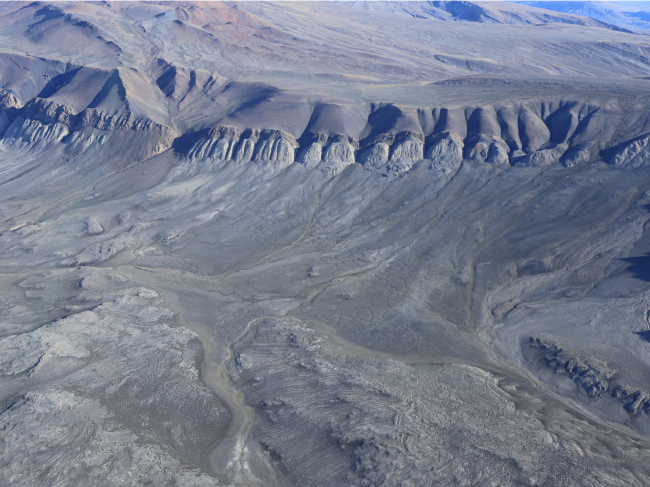
A warming climate is causing new stream systems to develop through previously frozen areas of the Canadian High Arctic. Scientists are looking at how freeze-thaw dynamics and the delivery of surface water by floods, snow and ice melt are converging to transforming this fragile landscape.
Simon Fraser University (SFU) environmental science professor Shawn Chartrand is a geophysical and environmental scientist who studies how rivers form and co-evolve with the land. His particular interest is mountain rivers and cold regions of the Arctic. His research is used to improve how professional scientists approach and develop river restoration plans, including the removal of dams.
Chartrand was a member of an international research team that visited the island of Axel Heiberg, Nunavut to document how climate change is altering the region—and to learn how similar changes may occur in other parts of the world.
For the field study the team focused on the Muskox Valley, east of the Muller Ice Cap. Using aerial photographs from 1959, and field observations and state-of-the-art Light Detection and Ranging (LiDAR) data from 2019 they observed how the Axel Heiberg Island landscape has evolved over the past 60 years. Their observations, High Arctic channel incision modulated by climate change and the emergence of polygonal ground, were published in Nature Communications.
The research team included scientists from the University of British Columbia, the Finnish Geospatial Research Institute, Laboratoire de Planétologie et Géosciences (UMR CNRS 6112), University of Western Ontario and the Jet Propulsion Laboratory.

Polygons and channel networks on the west side of Axel Heiberg Island. Photo by Shawn Chartrand
We spoke with professor Chartrand about his research.
What did you observe over the 60-year time lapse of the Arctic landscape?
Through several types of environmental information, we can piece together that roughly 60 years ago Muskox Valley generally lacked river channels, and the other types of features we are accustomed to seeing within valleys around the Vancouver Metro region. Fast forward to the present and Muskox Valley supports a developing river channel system, and one that is influenced by geometric patterns that emerged in the ground surface during this intervening time. The change we reconstructed is occurring much faster than expectation permits, which suggests that key framing concepts are missing from current explanations outlined by western science.
Why is this research important to understanding the effects of climate change in Canada and other parts of the world?
Muskox Valley is a harbinger of things to come. What we see today in the land or city around us, is not what we will see in 50 to 100 years, or sooner. The effects of climate change are a global problem, but climate change will bring geographically specific issues that society must address. This point is underscored not simply by rising air temperatures, but by the increased variability we are witnessing now in everyday life. For example, the fall 2023 floods in the Maritimes with three months of rain in just a few days, the forest fires ravaging Canada coast to coast last season, and the heatwaves across southern Europe, Asia and the United States last summer.
While we document rapid landscape change in the High Arctic, climate change is present in other parts of Canada. We will contend with longer dry seasons, which means streams and rivers will run dry, fire seasons will come earlier bringing local economies to a halt, and endanger life, wildlife, homes and ways of life. Increased river flows carry more sediment, stressing local water supplies and the production of drinking water which meets regulatory standards. Climate change is here. It is not a thing of the future, it is a thing of the present. The relatively placid conditions of the prior century or two are changing rapidly, and leading to a place where intense variability is the new norm, with society and landscapes adapting and changing to keep up. Muskox Valley is just one example.
What are “polygons?” Why are they significant when looking at Arctic landscapes?
Polygons are geometric shapes that form within soils and sediments located at the ground surface in cold regions, or in areas with clay-rich soils subjected to dry and hot seasonal conditions. They are called polygons because their physical appearance reflects the geometry of those five- and six-sided shapes we learned about in primary school math. In cold regions, polygons form through effects related to seasonal freezing and thawing of the near ground surface soils and sediments. In general, when the soils and sediments freeze in the fall and early winter, they get stretched and cracks form. Conversely when these same materials thaw in the spring and early summer, they relax and spread out. Over time this seasonal process leads to connected crack systems in the shapes of polygons.
Can you explain what is happening to the permafrost during warmer temperatures?
Under present-day conditions, permafrost is found in cold regions of the Earth at depths generally between 50 and 150 centimeters. At these depths, the subsurface material made of rocks and other materials is frozen, with little to no temperature changes over each year. Under climate change, the top of the permafrost is thawing due to more heat penetrating into the ground surface, causing the depths measured to the top of permafrost from the ground surface to increase.
What do you recommend regarding the stewardship of Arctic landscapes like the area you studied?
Landscapes of the Arctic are as vast and varied as any on planet Earth, and home to many Indigenous peoples who depend on the land and oceans for sustenance of their families. The Arctic is undergoing relatively rapid changes under present-day climate change. Landscapes in transition are vulnerable to many different future states, and difficult to project with confidence. The Arctic should be protected in the most absolute terms possible.
How interesting is it to work with a team of international scientists, including NASA’s Jet Propulsion Laboratory? Why is the international scientific community interested in the Canadian High Arctic?
One of the most rewarding parts of science is working on a team of people who are motivated by similar curiosities for the natural world, which gives teams direction and room for endless debates and discussions. Ultimately this yields stronger science, and provides fantastic opportunities for students and early career scientists. The Canadian High Arctic is a wondrous place, with landscapes that can keep one’s minds eye captivated year after year; the changes taking place in the High Arctic are mind-blowing from a scientific perspective, as we can literally see landscapes change wholesale on human time scales. On top of this the High Arctic is a place of planetary analogue research, where scientists test plausible ideas about how natural processes may work on other planetary bodies in our solar system.
For more: Read the SFU News story: New rivers in the North? Scientists identify how the dissection of Arctic landscapes is changing with accelerating climate change
SFU's Scholarly Impact of the Week series does not reflect the opinions or viewpoints of the university, but those of the scholars. The timing of articles in the series is chosen weeks or months in advance, based on a published set of criteria. Any correspondence with university or world events at the time of publication is purely coincidental.
For more information, please see SFU's Code of Faculty Ethics and Responsibilities and the statement on academic freedom.